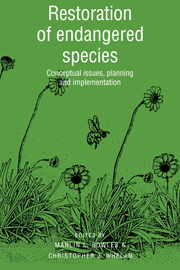Book contents
- Frontmatter
- Contents
- List of contributors
- Foreword
- Acknowledgments
- I Conceptual issues in restoration ecology
- 1 Organizational and managerial guidelines for endangered species restoration programs and recovery teams
- 2 Genetic considerations for plant population restoration and conservation
- 3 Managing genetic diversity in captive populations of animals
- 4 The relationship of rarity to plant reproductive biology
- 5 Experimental evidence for insect impact on populations of short-lived, perennial plants, and its application in restoration ecology
- II Restoration planning
- III Implemented restorations
- IV Synthesis and future directions: biology, politics and reality
- Taxonomic Index
- Subject Index
5 - Experimental evidence for insect impact on populations of short-lived, perennial plants, and its application in restoration ecology
Published online by Cambridge University Press: 27 January 2010
- Frontmatter
- Contents
- List of contributors
- Foreword
- Acknowledgments
- I Conceptual issues in restoration ecology
- 1 Organizational and managerial guidelines for endangered species restoration programs and recovery teams
- 2 Genetic considerations for plant population restoration and conservation
- 3 Managing genetic diversity in captive populations of animals
- 4 The relationship of rarity to plant reproductive biology
- 5 Experimental evidence for insect impact on populations of short-lived, perennial plants, and its application in restoration ecology
- II Restoration planning
- III Implemented restorations
- IV Synthesis and future directions: biology, politics and reality
- Taxonomic Index
- Subject Index
Summary
Introduction
Successful management of vegetation and the restoration of threatened or endangered plant populations clearly depend on the unambiguous identification of the factors that determine and limit plant abundance and distribution (e.g. Harper 1977, Jordan, Gilpin & Aber 1987). Physical conditions, plant physiological responses, and plant competitive interactions are often important (e.g. Harper 1977, Chabot & Mooney 1985, Pickett & White 1985, Grace & Tilman 1990), and these factors are usually evaluated. However, trophic interactions, such as those involving plant consumption by insects and pathogens, may also be critical in the growth, reproduction, and population dynamics of native plants (e.g. Harper 1969, Whittaker 1979, Rausher & Feeny 1980, Dirzo 1984, Howe & Westley 1988, Burdon 1987, Hendrix 1988, Burdon, Jarosz & Kirby 1989, Louda 1989), but are seldom evaluated in plans for the management or restoration of threatened plant species.
In this chapter, after presenting some background on insect herbivory in plant dynamics, I review several key results from two field experiments that excluded flower- and seed-feeding insects from native plants. I then use these results to: challenge the view that insect damage can be assumed to be irrelevant to plant success, suggest patterns of significant insect damage to seeds of native plants, and make two recommendations involving assessment of insect herbivory to improve the management and restoration of rare and threatened plant species. The evidence suggests that evaluation of insect herbivory is generally warranted.
- Type
- Chapter
- Information
- Restoration of Endangered SpeciesConceptual Issues, Planning and Implementation, pp. 118 - 138Publisher: Cambridge University PressPrint publication year: 1994
- 13
- Cited by

